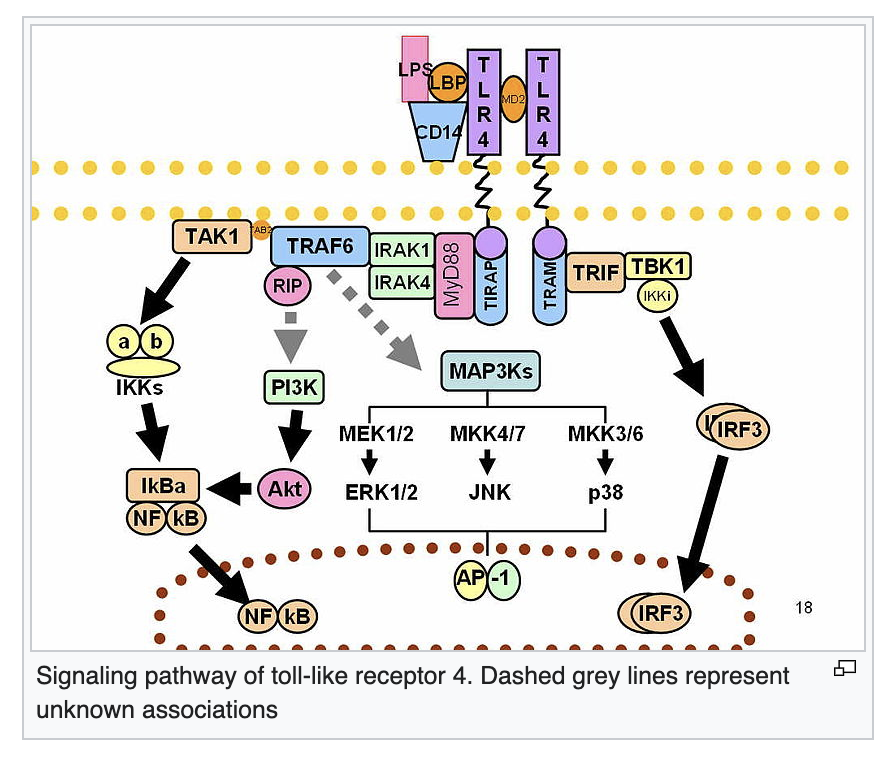Authors: Sky W. Brubaker, Kevin S. Bonham, Ivan Zanoni, and Jonathan C. Kagan
Synopsis
This review paper describes the molecular pathways involved in the innate immune response. I will focus specifically on the TLR4 pathway response to lipopolysaccharide (LPS), as this pathway is one that I am studying in my own research.
Summary

This figure summarizes the entire TLR4 pathway, which includes signaling from both the cell surface and from endosomes. Here is an alternate figure of the same pathway from Wikipedia:

LPS multireceptor complex
The LPS multireceptor complex is the first thing that binds to LPS and activates the TLR4 signaling pathway. It is made up of 4 genes:
- TLR4 (Toll-like receptor 4)
- MD-2 (Myeloid differentiation factor 2) aka LY96 (Lymphocyte antigen 96)
- CD14 (Cluster of differentiation 14)
- LBP (LPS binding protein)
LBP binds to LPS and facilitates the transfer of LPS to CD14. CD14 then transfers LPS to TLR4-bound MD-2, which dimerizes TLR4 leading to signal transduction. CD14 also helps traffic TLR4 from the plasma membrane into the endosomes, resulting in additional signal transduction.
TIRAP/MyD88 pathway
This pathway occurs immediately following the previous one and occurs from the cell surface. It comprises the following steps:
- TLR4 moves to lipid rafts and interacts with TIRAP (TIR Domain-Containing Adaptor Protein)
- TIRAP oligomerizes with MyD88 (Myeloid Differentiation Primary Response Gene 88) and IRAK1/2/4 (IL-1 Receptor Associated Kinases) to form a myddosome
- IRAKs recruit TRAF6 (TNF Receptor-Associated Factor 6)
- TRAF6 recruits kinase complexes containing TAK1 (Transforming growth factor-beta-Activated Kinase 1, aka MAP3K7) and TAB1/2/3 (TAK1-Binding protein)
- IKKa/b/g (IkB Kinase aka CHUK, IKBKB and IKBKG) gets recruited and activates NF-kB. NF-kB leads to downstream effects including production of proinflammatory cytokines such as IL-12 and TNF.
- TAK1 (aka MAP3K7) gets released into the cytoplasm and acts as a MAPKKK (mitogen-activation protein kinase kinase kinase). The MAPK cascade leads to activation of AP-1 (activator protein 1), involved in expression of proinflammatory cytokines.
TRIF/TRAM pathway
In addition to the TIRAP/MyD88 pathway (which occurs from the cell surface), TLR4 signaling also continues from endosomes.
- TLR4 engages TRAM (TRIF-related Adaptor Molecule aka TICAM2)
- TRAM interacts with TRIF (TIR-domain-containing adaptor inducing interferon-beta aka TICAM1)
- TRIF interacts with RIPK1 (Receptor Interacting Serine/Threonine Kinase 1), TRADD (TNFRSF1A Associated via Death Domain), CASP8 (Caspase 8), FADD (Fas-associated protein with death domain aka MORT1), and IKKa/b/g to start NF-kB signaling
- TRIF also recruits TRAF3
- TRAF3 interacts with TANK (TRAF family member-associated NF-kB activator) to recruit IKKg/e and TBK1 (TANK binding kinase 1), which activates IRF3 (Interferon regulatory factor 3)
- IRF3 is a key transcriptional regulator of type 1 interferon response. The type 1 IFN response involves 6. IFN-a and IFN-b.
TLR4-independent CD14 signaling
CD14 can also signal in response to LPS independently of TLR4. One pathway induces calcium influx via NFAT activation. Another pathway controls endocytosis and moves TLR4 from the plasma membrane into endosomes. The second pathway depends on ITAM (immunoreceptor tyrosine-based activation motif), Syk (a tyrosine-protein kinase), and PLCg2 (phospholipase C gamma 2).